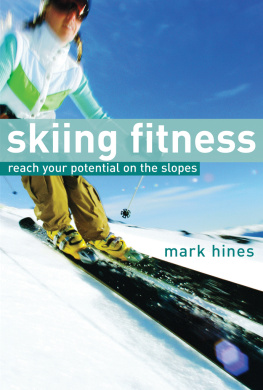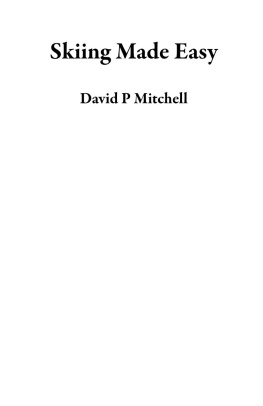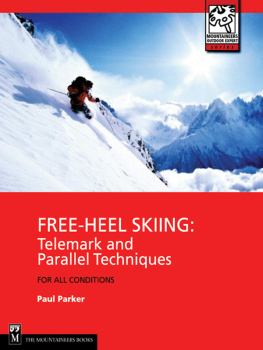
This electronic edition published in 2015 by Bloomsbury Publishing Plc
First published in 2006 by
A&C Black Publishers Ltd
38 Soho Square, London W1D 3HB
www.acblack.com
Copyright 2006 Mark Hines
ISBN-10: 0 713678348
ISBN-13: 9780713678345
ePub: 9781472902238
All rights reserved
You may not copy, distribute, transmit, reproduce or otherwise make available this publication (or any part of it) in any form, or by any means (including without limitation electronic, digital, optical, mechanical, photocopying, printing, recording or otherwise), without the prior written permission of the publisher. Any person who does any unauthorised act in relation to this publication may be liable to criminal prosecution and civil claims for damages.
A CIP catalogue record for this book is available from the British Library.
Note: It is always the responsibility of the individual to assess his or her own fitness capability before participating in any training activity. While every effort has been made to ensure the content of this book is as technically accurate as possible, neither the author nor the publishers can accept responsibility for any injury or loss sustained as a result of the use of this material.
Text and cover design by James Watson
Cover image Corbis
Images on Corbis. All the other images Grant Pritchard
To find out more about our authors and books visit www.bloomsbury.com. Here you will find extracts, author interviews, details of forthcoming events and the option to sign up for our newsletters.
Contents
Acknowledgements
I would like to thank a number of people for making this book possible. Firstly, I would like to thank both of my parents for teaching me to ski from a young age, and for taking me to a number of beautiful places around the world where I could practise.
On a technical level, I would like to thank my dear friend John Hardy, as an authority on all matters relating to biomechanics and exercise prescription. It is through the existence of John that I have always had somebody at hand that I can phone up and argue with about many issues surrounding exercise science and kinesiology. Most importantly, it is good to have somebody to agree with when we find ourselves challenging the status quo.
Also on a technical level, I would like to thank Dr Mike Langran for his input on the sports injuries section. I am most grateful that he allowed me to use some of the statistics and information from his website; www.ski-injury.com
Finally, I would like to thank my two models, Emily and Stephen, for their help in making this book happen. They have both been wonderful colleagues and are good friends. I have enjoyed training with them in the past, and am grateful for the time and commitment that they put in to getting the photographs right for this book.

Introduction
Skiing is becoming more accessible to a greater range of people all over the world. The sport has spread from its origins in Scandinavia to just about anywhere that has a hill and sees some snow. With the growing sophistication of artificial indoor and outdoor slopes, skiing is not only available to more people but can also be practised to a greater standard than on older dry slopes. Despite the growing numbers of practitioners, the increasing number of ski lifts and pistes means that there are many places that can be skied free from the crowds.
With more people skiing on- and off-piste, it is important to ensure that all skiers are appropriately physically conditioned. For those who ski all year round, this can be a good opportunity to improve muscle and joint function, and apply it directly to improve technical skills. For those who go skiing only once or twice a year, being physically conditioned will enable them to get the most pleasure and development from their skiing trips.
The purpose of this book is to introduce you to the most effective exercises for skiing. Indeed, the exercises will develop the body of anyone, regardless of how adept they are at skiing. The plan is to treat the body as a functional unit, developing that unit for the specific tasks required of it when skiing so as to improve technique and fitness. While this is not a book about developing technical skills something best learned on the slopes it does set out to train the individual to be better able (from a specific fitness perspective) to develop technical skills.
As an exercise scientist specialising in biomechanics, my work involves studying the way people move and then finding ways to improve their movement and reduce their risk of injury or pain. You may be surprised to learn that there are very few top athletes with fantastic biomechanics. This is not to say that moving badly is good because these people are likely to pick up muscle injuries (weve all heard of footballers and sprinters tearing their hamstrings) and may suffer from even more problems later in life.
Regardless of what level of skier you are whether an absolute novice or a gold medallist you can improve your abilities on the slopes and decrease your risk of injury. I have never met anybody who suffered from a slight skiing injury, or was only slightly sore the day after their first day on the slopes. So, we shall begin at the beginning. We will get you moving properly first, to ensure your joints are doing what they are supposed to, and then we will start increasing the demands of the training over the course of several weeks. This will have the effect of developing the body specifically for the rigours of skiing while maintaining optimal joint positioning. In short, you will be moving properly and performing what I believe to be the best course of skiing programmes ever devised. I write that because most skiing programmes tend to train the legs and arms, which is interesting but not specific enough to do much good, but more on that later.
From a safety perspective, the fitter someone is, the less likely they are to have an accident. There are, however, many types of fitness. Although we tend to have a preconceived idea of what we would describe or recognise as fitness, we can quite easily miss out on some important factors. We could describe a marathon runner as fit, and we could describe an Olympic power-lifter as fit, and although we would be correct both times, they are clearly very different types of fitness, and one type is by no means more important than the other. Someone who plays chess could be described as mentally fit, and they could train to improve their mental fitness, but this in itself would not make them fitter for any physical function.
Flexibility, strength, endurance, power, cardiovascular ability, balance, proprioception (detailed later), stability and nervous function are all important and independent types of fitness. When all these factors that contribute to skiing fitness are developed, physical and mental fatigue can be offset or prevented, thereby improving all-round ability to ski to the best standard that your technique will allow. Technique itself can then be developed far better than if the body lacks sufficient levels of fitness in any of the factors mentioned.
Most importantly, fitness, in whatever guise, can be improved through developmental training. This means starting from whatever skiing or exercising background whether novice, beginner, intermediate, advanced or professional and improving ability through small but significant steps. The exercises included in this book make up a course of different programmes. They are intended not just to take the beginner to an advanced stage, but to take anybody from any level and allow them the opportunity to make natural and comfortable progressions far beyond those that might be derived from other programmes or by skiing alone.
Next page








